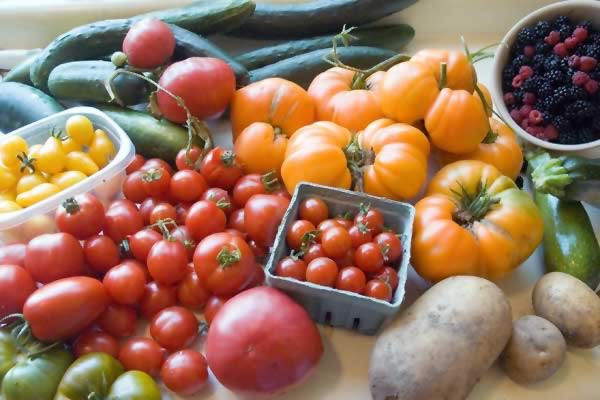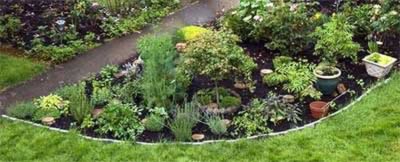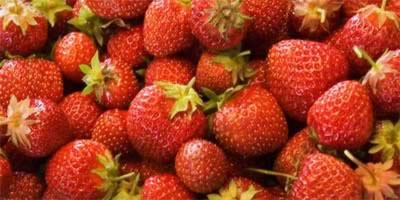Gardening 101: Plan Today for Summer Success

This was an actual weekend harvest from our garden last August.
At Get Rich Slowly, we get many requests for information about starting a vegetable garden. This is huge topic, and really enough fodder for an entire website. If you’re a novice gardener you will benefit by asking yourself six questions before mail-ordering seeds or heading to your local nursery. Now is the time to do your research so that you’ll be ready for planting season.
Do you actually like to eat vegetables?
If not, focus on fruits and herbs, edible and ornamental flowers, and a favorite veggie or two. A well-tended garden will produce a lot of vegetables. If you are lukewarm about zucchini then pass up that beautiful seedling. (Or go introduce yourself to your five nearest neighbors so that you can share come July).
What is your gardening space like?
This is probably the most important question for the novice gardener. If you are starting from bare dirt or, more likely, a patch of lawn, you have some work to do. The plot needs to be evaluated for sun and wind exposure, moisture/drainage, soil pH and elemental content, pests, and other factors.
Crop gardens need a sunny spot. But remember that the angle of the sun in the summer months will be different than it is now. Nonetheless, try to watch over the next few weeks to determine where the sun hits your property. If I have to choose between morning sun and evening, I prefer morning sun — it is less intense, which means watering needs are decreased. Here in Portland, however, it’s hard to give a garden too much sun.
Get online and tap the resources at your local university’s extension offices. You can usually find them just by searching for your state’s name and “extension service”. Many states offer free soil testing, which will tell you how to amend the soil if nutrients or organic matter are lacking, or if the pH of the soil needs to be adjusted. Your county’s Master Gardener program may also offer this service. Each crop has an optimum pH growing range. We add acid for our blueberries and strawberries; kale and peas like a slightly alkaline soil. If your soil is close to neutral (pH 7), you can probably proceed as-is.
In May they’re ready to be transplanted!
Even if your soil is terrible, you still have options. On a small scale, container gardening can be rewarding. A cherry tomato, well-watered, can do well in a large pot on a patio. Better yet, build some raised beds. These will require an initial investment for the soil to fill them and construction materials, but they provide better drainage, warmer soil temperatures in the spring (and thus earlier crops), and reduced weeding. (Please avoid pressure-treated lumber, though, there is some evidence that the toxic chemicals leach into the soil. Okay for a picnic table, but not for the dirt where your eggplant is growing!)
If this all seems rather intimidating, I encourage you to start small. Don’t roto-till the entire lawn under until you really decide that crop gardening is for you. If your gardening space is less than ideal but you’d like to take the plunge, perhaps one 6’x12′ foot raised bed is the perfect beginning. Or try growing herbs.
Herbs are one of the most forgiving classes of plants to grow — almost as easy as weeds — especially the hardy perennial herbs. Except for excessively moist soil and total shade, almost any conditions will support herbs. They thrive in sunny, dry areas. Herbs are also some of the most frugal crops you can grow because they are outrageously priced at the grocery store and can be used to make even basic ingredients into a stand-out meal. It’s worth the cost to start with herb plants rather than seeds so that you can use them right away.
Perennial herbs like sage, rosemary, thyme, lemon verbena, mints, chives and oregano require very little work. Again, do your homework for your climate. And a word to the wise: some herbs are invasive. Mints have spreading roots that will take over your entire city block. They are best in a container with a solid bottom rather than planted directly in the ground. Others, like oregano and fennel, spread easily by dropping their seeds. If you want to avoid little fennel and oregano families, be sure to trim off the flowers before they go to seed.

Last year we added an herb garden.
Short term, long term, or both?
Plants generally fall into two categories: annuals or perennials.
Annual crops start from a seed, mature and bear fruit (or vegetable) in one season, then die. In our region, corn is an annual, as are cucumbers, watermelons, and tomatoes. Plants that can survive the winter to regrow for another crop season are typically perennials, Examples include asparagus, blueberries, artichoke, and rhubarb. This also applies to flowers, of course: sunflower (annual) versus rose (perennial). I tend to think of fruits in the perennial group: fruit trees and berries are perennials. Most vegetables (again, this is for my climate) are annuals. Obviously there are exceptions to this generalization, like the melon family.
To decide where to focus your gardening energies, you should know your climate zone. This will help you determine the length of your growing season and which annual crops are going to have time to ripen.
Perennials usually cost more than annuals initially (buying an apple tree sapling, for example), and will require patience. We planted asparagus two springs ago and are hoping for our first taste this April. But these plants are longer living, and give you bigger returns for relatively little work. Asparagus plants can live for twenty years before needing replacements; an apple tree may not bear a crop for the first five years, but may live to be one-hundred.
If you’re just getting your gardening feet muddy for the first time, I recommend annuals. Tomatoes are extremely rewarding, as are other salad fixings such as lettuce, spinach, cucumbers, radishes and carrots. Other easy crops to start with are beans, onions (or leeks/shallots), potatoes, and pumpkin (although this needs room to spread). Besides the instant gratification they provide, mistakes with annuals are easily corrected the next season without much expense. Did the birds eat all your peas? Try something next year to protect them. Has your corn crop failed? Next spring, try it in a sunnier place.

Our strawberry plants have spread like crazy in the past three years.
If you have enough space and the inclination, try a bit of both annuals and perennials. A strawberry patch won’t produce much the first year, but the plants will reproduce and spread to give you a bounteous crop. Dwarf fruit trees are a nice option if you are looking for an ornamental small tree; most have beautiful blossoms, too. And don’t forget those herbs!
(We never get many filberts — our yard is home to a Kingdom of Squirrels.)
Who are your gardening neighbors?
Tap those resources. Most gardeners love to talk about their plants. You can learn a lot about what works for your area by listening to their stories of success and failure. If you do a bit of pre-planning, you could also take part in a seed co-op. A typical tomato seed packet may hold 30 seeds — more than enough to split among four gardeners. Many vegetable starts are sold as single pots, but some come in six-packs that can be easily shared. With knowledge and experience, you can even harvest seeds from local gardens (with permission, of course) to plant the following spring. And if you’re lucky, when it’s time for the woman across the street to divide her lavender bush, she’ll share half with you!
Can you control yourself?
Most seed packets run only $2-$3, so they are tempting. But spending money and wasting your time on plants that won’t do well in your garden is an exercise in summer-long frustration. Evaluate your space and the soil and sun conditions. Learn to avoid catalog phrases such as “spreads quickly” or “freely self-sows” unless that’s what you really want. Don’t trust the catalog! The pictures are tempting, but they often show the plant only at its peak — what will it look like the rest of the time? Is it invasive? Poisonous? Hard-to-grow? Will it require constant maintenance? Use the internet and your library’s garden references to research seeds and plants before you buy them. I have found the internet to be a wonderful alternative to a knowledgeable nursery employee.
Do you have the time and money to grow your own food?
Gardening, initially, isn’t cheap. Besides plants and seeds, you’ll need garden tools, fertilizers, soil amendments, watering devices and a million other small things. But for those who savor its rewards, gardening is a labor of love. With time, and smart choices, having a kitchen garden does pay off financially. Herbs will pay for themselves quickly, and over the years, so will the berry bushes and canes, fruit trees and fresh vegetables. J.D. and I literally ate several hundred dollars of free homegrown berries this past spring and summer — all from a bit of our own labor, a few supplies and the investment of the canes and bushes. And that crop will only be bigger next year.
Most gardens, even sizable ones, can be maintained with thirty minutes of work per day. Hoe weeds while they’re small, mulch properly, water wisely and be timely about harvesting. But if you let the garden tasks slip for a week or two, you may face a daunting task of huge weeds, spoiled crops or everything dead from lack of water. Gardening requires a time commitment if you want to reap the benefits.
Other Thoughts
If you are a beginning gardener, start small. Build on your successes. Be wise: it’s easy to dive in headfirst and then be overwhelmed. Research the plants you want to grow and the conditions they require, build a manageable raised bed if you’re starting from scratch, and use local resources to gain knowledge and cut costs.
Gardening requires a bit of seed money to begin, but the rewards are many! Healthier, fresher food, time in the great outdoors and a connection to nature, as well as engaging in an activity that can build community. And I haven’t even mentioned how much more excited kids are to eat their vegetables when they helped grow them or how people appreciate a homemade gift from the garden — whether a beautiful bouquet, and bunch of fragrant herbs, a fresh salad or a jewel-toned jar of jam.

In January fresh tomatoes are but a gardener’s dream.
Final Note
I recommend keeping your vegetable/fruit garden as organic as possible. One of the greatest benefits of growing your own is avoiding the pesticides (et al) on grocery-store goods. Insect diversity in your yard may be enough to keep pests in check; if you have an outbreak, simply try spraying with lightly soapy water, or other low-impact methods. If your soil is healthy and the plants are well-nourished, the plants will be strong and the bugs will be kept at bay.
This may not be practical in all climates, but here in Oregon, a few minutes each night hoeing will keep down the weeds, and the plants can take some munching by a bug or two once they’re established. With fertilizers, most choices are fine. I like an organic foliar spray — one that goes directly onto the leaves of my plants — but the crystalline concentrates that you mix with water can be fine as well, as long as your soil is already full of good organic matter and friendly worms.
Here are some additional resources:
- Garden Web — “The internet’s garden & home community.”
- National Gardening Association: USDA Hardiness Zone Finder
- Gardens Alive! — “Environmentally responsible products that work!”
Happy gardening!
Become A Money Boss And Join 15,000 Others
Subscribe to the GRS Insider (FREE) and we’ll give you a copy of the Money Boss Manifesto (also FREE)

